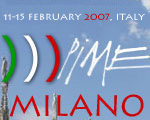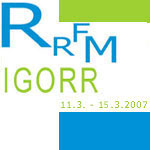
Summary of a Feasibility Study into the construction
of a new nuclear powerplant in Lithuania
25 October, Vilnius
BACKGROUND
On 26th January 2006, during an energy
conference in Vilnius, government officials from three Baltic
countries agreed to commission a feasibility study into the construction
of a new nuclear power plant in the region. January 2006, during
an energy conference in Vilnius, government officials from three
Baltic countries agreed to commission a feasibility study for
a new nuclear power plant in the region.
On 27th February 2006, the Prime Ministers
of Lithuania, Latvia and Estonia issued a communiqué expressing
their approval of the construction of a new nuclear plant in the
region and inviting national energy companies to invest in the
Project.
The Memorandum of Understanding about conducting
the feasibility study was signed by the heads of Lietuvos Energija,
Latvenergo and Eesti Energia on 8th March 2006.
INTRODUCTION
The Baltic electrical system and – as a
result – the economies of the Baltic States are facing a
major challenge as they seek to make progress. According to the
EU accession arrangements for Lithuania, the nuclear power plant
facilities operating today at Ignalina will have to be closed
down, causing a major shift in the electricity supply and demand
equation - not only in Lithuania but also in the integrated Baltic
electricity system, which includes Estonia and Latvia.
It is for this reason that the three governments
of Estonia, Latvia and Lithuania have decided to jointly explore
possible options for addressing this issue with the utmost urgency.
One of the options considered entails building a new nuclear power
plant in Lithuania, effectively replacing the existing obsolete
Ignalina units with up-to-date and optimally safe nuclear power
production technology. In order to assess the feasibility of this
particular option the three governments requested their respective
state owned utilities - Eesti Energia, Latvenergo and Lietuvos
Energija AB (the “Sponsors”) to carry out the feasibility
study.
The work within the framework of the feasibility
study was split among the following four working groups:
-
Best Available Technologies Group: for the
new nuclear plant, i.e. possible reactor size, and the potential
investment and operational costs of the facilities
-
The Financing Working Group: responsible
for economic and financial appraisal of the Project
-
The Legal Working Group: responsible for
structuring the project in the light of the applicable legal,
contractual, regulatory and EU legislative requirements
-
The Transmission Working Group: responsible
for investigating the adequacy of the Baltic transmission
system for ensuring power flows from the new plant in Ignalina
to power systems in all countries involved and estimating
the reserve capacity required after construction of the new
plant
The Sponsors appointed advisors to assist with the financial,
technical and legal analysis of the feasibility of the project
(Dresdner Kleinwort, Freshfields and Colenco Power Engineering).
Figure 1. Main parties involved in preparation
of the Feasibility Study

GOAL OF THE FEASIBILITY STUDY
Given the task assigned to the Sponsors by the
respective governments , the main goal of this feasibility study
has been to assess whether it is realistic to envisage that a
NPP could be successfully developed in the current and prospective
economic, technical, financial and legal environment in the Baltic
States and the EU. This analysis was based on information available
today on:
-
available reactor technologies
-
the current market environment for commodities (in particular
oil and gas),
-
the legal and regulatory framework for nuclear generation
in the Baltic region
-
the applicable legal framework in Lithuania and the EU
-
the technical status of the interconnected Baltic system
-
the current and forecast financial status and the financial
and market environment
CONCLUSIONS
The main conclusion of the study is that it would be feasible
to develop a new nuclear power plant to replace Ignalina.
The key factors supporting this conclusion are as follows:
-
There is a clear need to replace the capacity
that will be lost when Ignalina is finally closed
-
Replacing Ignalina with new nuclear capacity
offers a number of important advantages compared with available
alternatives. In particular, it will maintain diversity of
fuel source and generation mix; it will reinforce security
of supply by using fuel that is readily available from a global
market and it will assist in meeting Kyoto Protocol emissions
targets
-
Replacing Ignalina with one of the range
of modern nuclear plants that meet current international safety
and environmental standards will also deliver substantial
public benefits
-
The work done also shows that there is good
reason to expect that the project could be successfully implemented
in practice.
-
From a technical standpoint, the study of
available reactor technologies shows that there is a satisfactory
range of proven reactors that would be suitable for use and
that would meet prevailing international safety standards.
The assessment reveals that the current Ignalina site is suitable
for developing a new reactor(s). The study also shows that
the current transmission grid would be able to cope with the
new power plant with little and manageable reinforcement and
adaptation. It indicates that short-term storage of spent
fuel would continue for Ignalina, that long term storage options
for existing and future spent fuel are to be developed in
the context of EU-led initiatives, and that the new plant’s
storage costs would be financed on the basis of regular contributions
to an independent fund, in line with best European practice.
-
From an economic perspective, the study also
indicates that nuclear is a more viable choice for new capacity
than alternative forms of power generation, based on current
fuel prices and projections and on the expected range of reactor
prices. Financial analysis and initial consultations with
potential lenders also indicate that it would be feasible
for the sponsors to provide the necessary equity and to cover
the debt incurred. This will, of course, require that the
financing is suitably structured and that appropriate commercial
contracts for a project of this kind are put in place to support
the financing. It will also require that processes currently
under development to ensure that each sponsor is sufficiently
capitalised to support its share of the financing are, in
due course, implemented. There is good reason to think that
these steps are achievable
The analysis undertaken in the context of this
study indicates that today the undertaking of the three sponsors
to jointly build a new nuclear power plant appears feasible from
a technical, electrical system, financial and legal perspective
on the basis described above. More specifically, conclusions have
been drawn with regards to the following parameters listed:
The analysis indicates that given the current
and forecast economic development for all three Baltic States
a significant supply and demand gap will be apparent. This is
exacerbated by the closure of Ignalina. As a result, significant
new capacity needs to be built to fill the gap. Nuclear generation
capacity is one major source of energy for filling the supply
and demand gap that must be considered.
The analysis indicates a cost advantage for the
analysed reactor designs compared to other forms of likely generation
capacity upgrades to the Baltic electricity system.
Using different estimates for oil and coal prices,
it has been possible to assess indicative ranges for generic new
entrant costs. The Project’s economic feasibility will thus
be based on the assessment of whether the all-inclusive costs
for the project, including full financing costs, could be reasonably
assumed to be below such new entrant cost levels.
Figure 2. Indicative electricity
generation new entry costs for different fuels

Source: Dresdner Kleinwort Equity Research
The study entailed an extensive, albeit preliminary,
assessment of reactor technologies available today. This exhaustive
market survey confirmed that all these reactor types present the
highest of safety standards, which exceed safety levels currently
in operation at Ignalina and would be at least as high as those
applicable to other European reactors. Furthermore, it appears
that there is sufficient variety of suppliers available for such
reactors to provide a competitive environment at the procurement
stage.
The nuclear fuel market is effectively a global
market supplying over 400 nuclear installations, in recent decades,
with nuclear fuel in a reliable, efficient and cost- effective
manner. It is important to bear in mind that the actual cost of
the nuclear fuel represents only a small part of the overall cost
base for any nuclear reactor. In addition, sources of uranium
are fairly well-distributed geographically, so that no particular
region is in a dominant position. Furthermore, relevant international
studies indicate that sufficient levels of uranium reserves are
available. While a few reactor types have technical specifications
which limit the number of suppliers of particular services for
fuel delivery, the overall market for such services, however,
is diversified to avoid any potential problem with regards to
security of supply.
Using the International Atomic Energy Agency’s
(IAEA) standards for evaluating the possible site options, it
has been concluded that sufficient space at the existing Ignalina
site is available to accommodate a new nuclear reactor unit. Drilling
and geological research has been carried out which support these
conclusions.
According to the information provided by potential
suppliers and the experience of the technical advisor, the average
number of staff required to operate a new nuclear plant is between
400 and 500 persons. An assessment of the age and qualification
structure of the personnel at the existing nuclear facility in
Ignalina indicates that following an education management process,
eligible current employees could constitute the majority of the
staff at the new plant.
The envisaged approach for decommissioning and
storage costs is - in line with European and national regulations
and best practices - to make the project responsible for making
regular payments to a separately held fund, which provides for
the future costs of decommissioning of the power station and of
the long-term storage of spent fuel. The level of contribution
would be fixed periodically by an independent authority on an
objective basis so as to ensure that the fund is adequate. The
project would pass on these costs to its customers under power
purchase agreements. Lithuania already has to identify the most
appropriate approach for storing its existing spent fuel materials
from Ignalina’s past operations. Thus, building a replacement
nuclear power plant does not present a new challenge, - indeed
the additional spent fuel volumes from the project will, in economic
terms, probably reduce the unit cost of overall storage through
economies of scale; and the establishment of a fund to finance
the cost of the project’s storage and decommissioning needs
will create financial stability that will assist with the development
of storage and decommissioning facilities for the site as a whole.
Regarding the latest UCTE requirements and the
current status of the integrated transmission systems of the Baltic
States, the analysis indicates that the current infrastructure
and electrical system is capable of accommodating up to 3,000MW
of nuclear capacity without major modification. In this context,
a detailed analysis has been undertaken of the likely cross-border
flows under various scenarios, as well as an analysis of the necessary
arrangements with regards to primary, secondary and tertiary reserves
to support different configurations of reactor types and unit
numbers. All this analysis supports the overall conclusion that
the project is technically feasible.
It was concluded that strong level support from
the sponsors will be required - either directly and/or indirectly
via off-take undertakings - would mean that the sponsors’
rating assessments are likely to include a pro rata participation
in the project itself, irrespective of the corporate structures
employed. Furthermore, it was concluded that a fully integrated
financing package is more economic, more flexible and less complex
than a project finance approach for integrated construction and
operation phases on a non-recourse basis.
The overall investment cost is expected to be
indicatively between €2.5 - 4.0 billion, depending on the
reactor type chosen and the number of units to be installed, amongst
other parameters. In addition, it is assumed that a not insignificant
amount of equity from the sponsors would be required.
The study has confirmed that under the envisaged
project structure described above, the sponsors could select any
of the reactor types available today for the project, i.e. there
are no restrictions from a financial, technical, system or legal
perspective to any single design. In addition, the analysis indicated
that for some of the designs it may well be possible to contemplate
constructing two units, which could provide certain additional
benefits, such as economies of scale, future procurement benefits,
and reserve capacity benefits. These benefits, however, have to
be weighed against the ability of the sponsors and ultimately
the Baltic market to absorb such quantities of electricity.
As indicated above, no substantial legal obstacles
to the successful implementation of the project have been identified,
assuming that appropriate commercial arrangements are successfully
negotiated, that the necessary legislative changes are introduced
and that the technical environmental and economic requirements
for applicable regulatory and other authorisations are met.
Main Parameters
Capacity needed |
800-1600 MW |
Investments |
2.5-4 billion Euros |
Overnight capital cost |
1300-2000 Eur/kW |
Possible project completion |
2015 |
NEXT STEPS
Clearly, this assessment is based on current
expectations for likely price evolution for fuel, carbon, reactor
and financial markets and for the outcome of various negotiations
with third parties and the results of detailed environmental impact
assessments, design work and regulatory approval processes. The
recommendation is that work should start on implementing the project,
subject to regular periodic governmental review to verify that
no circumstances have arisen which would adversely affect the
feasibility of the project and subject to final approval once
full details of the reactor price, financing package, commercial
arrangements and other key elements of the project have been negotiated.
Implementing the project is a substantial task
requiring many interrelated technical, commercial, financial and
legal work streams. It will involve negotiations with a variety
of commercial parties and consultations with and approvals from
a variety of regulatory authorities at national and EU level.
Implementing legislation will be necessary in the host country
and appropriate inter-governmental and government support agreements
will need to be entered into before financing and other final
commitments are made.
A summary of the Report for Feasibility Study
of Constructing a New Nuclear Plant in Lithuania will be presented
to governments and the parliaments of Lithuania, Latvia, Estonia
by November, 2006.
WHY NUCLEAR TECHNOLOGY?
While there are various options for replacing
the generation capacity lost through the shut down of Ignalina,
it is important to highlight in this context the main reasons
why nuclear reactor technology should be considered:
-
It allows sponsors to maintain the current
mix of fuels used in the Baltic electricity system and thus
maintain a diversified generation structure
-
It contributes to security of supply as
it uses nuclear fuel from a global market without material
security of supply concerns
-
Given the high construction cost and low
operating cost of nuclear operations, significant value would
likely be created in the domestic economies as opposed to
wealth transfer on an ongoing basis to the fuel supply markets
-
It will help meet Kyoto Protocol targets
for CO2 emissions, while at the same time supporting
growth of the domestic economies
-
Nuclear technology offers a relatively stable
and predictable initial cost base
-
Potential economies of scale may arise in
the establishment of final storage facilities for nuclear
fuel from the current Ignalina plant and the proposed replacement
-
The combined effect of the current high commodity
price environment for oil, gas and coal - coupled with a low
interest rate environment - could make the economics particularly
attractive
While there are significant political and environmental
concerns regarding nuclear generation, it appears that today’s
technologies are able to provide a safe and sound framework for
assessing and mitigating these concerns to a very large extent.
The governments and sponsors involved in the project, if it were
to go ahead, would clearly need to ensure that concerns on these
issues are met through appropriate standards, transparency and
public debate. The environmental and safety standards
of the proposed site would, of course, be verified in due course
in accordance with applicable Lithuanian licensing procedures. |







